Perched on the dramatic coastline of Newport, Rhode Island, The Breakers is anything but your average summer cottage. Built in 1893 for Cornelius Vanderbilt II after the original home burned down, this 70-room Italian Renaissance-style palace is Gilded Age grandeur at its peak.
It’s what happens when endless railroad money meets over-the-top European elegance, subtlety didn’t stand a chance. Every inch is dripping in craftsmanship and opulence.
If you’ve ever wondered how the ultra-rich vacationed back then, this place answers with a jaw-dropping, unapologetic flourish.
1. The Great Hall’s Soaring Statement
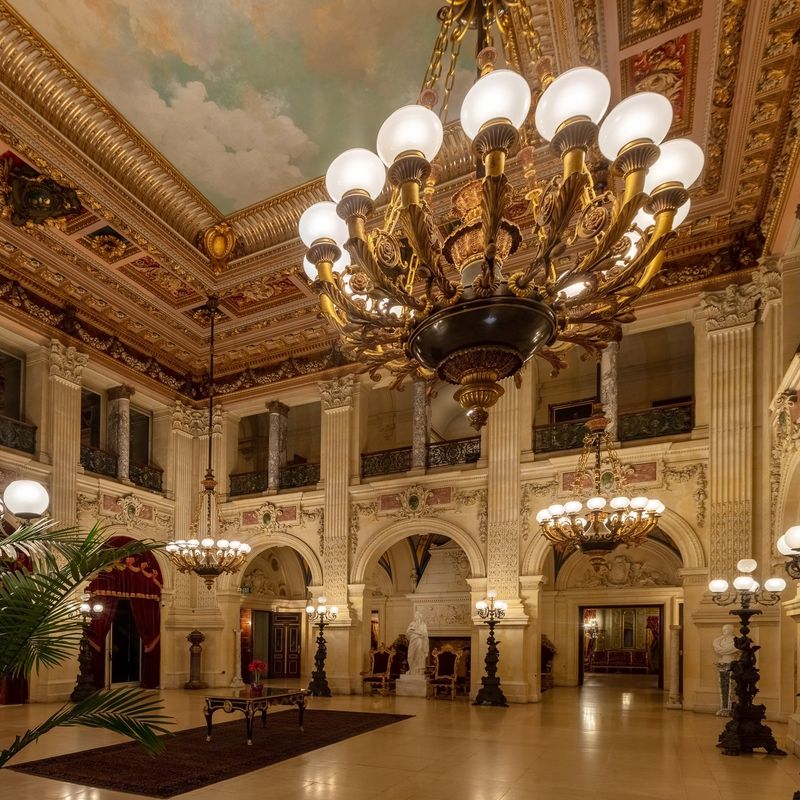
Fifty-foot ceilings greet visitors immediately, announcing the Vanderbilt fortune with cathedral-like grandeur. Imported Italian marble columns support arches that frame the space like a Renaissance painting come to life.
Architects Peabody and Stearns designed this entrance hall to humble guests before they’d even removed their hats. Alabaster chandeliers dangle overhead like crystallized wealth, while intricate mosaic floors whisper beneath every footstep. *Because subtle entrances are for people with smaller bank accounts.*
2. Morning Room’s Golden Glow
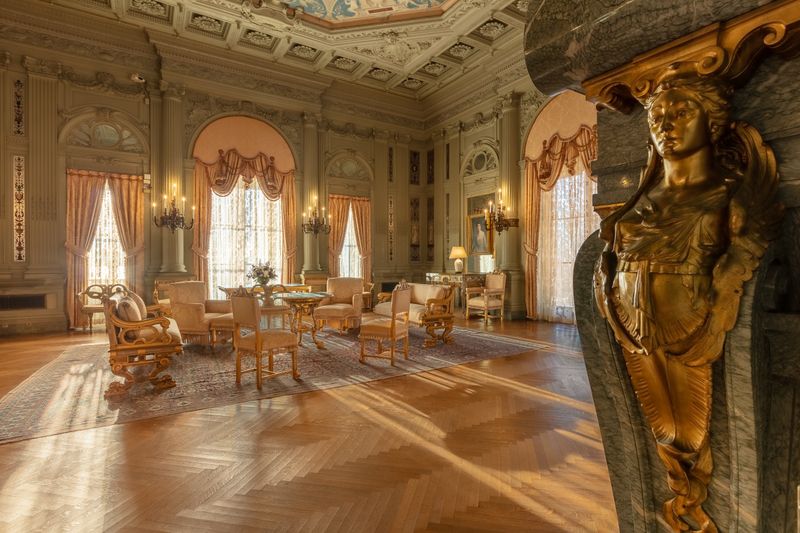
Sunlight dances across gilt surfaces in the Morning Room, where Mrs. Vanderbilt once received her closest confidantes. Platinum leaf details shimmer against cream-colored paneling, creating an ethereal luminosity that made even morning small talk feel momentous.
French designers Allard and Sons crafted a space where every surface celebrates craftsmanship. The ceiling alone features hand-painted panels depicting the four seasons, framed by moldings that took artisans months to perfect. *Morning coffee tastes better when your ceiling costs more than most homes.*
3. Billiard Room’s Masculine Power Play
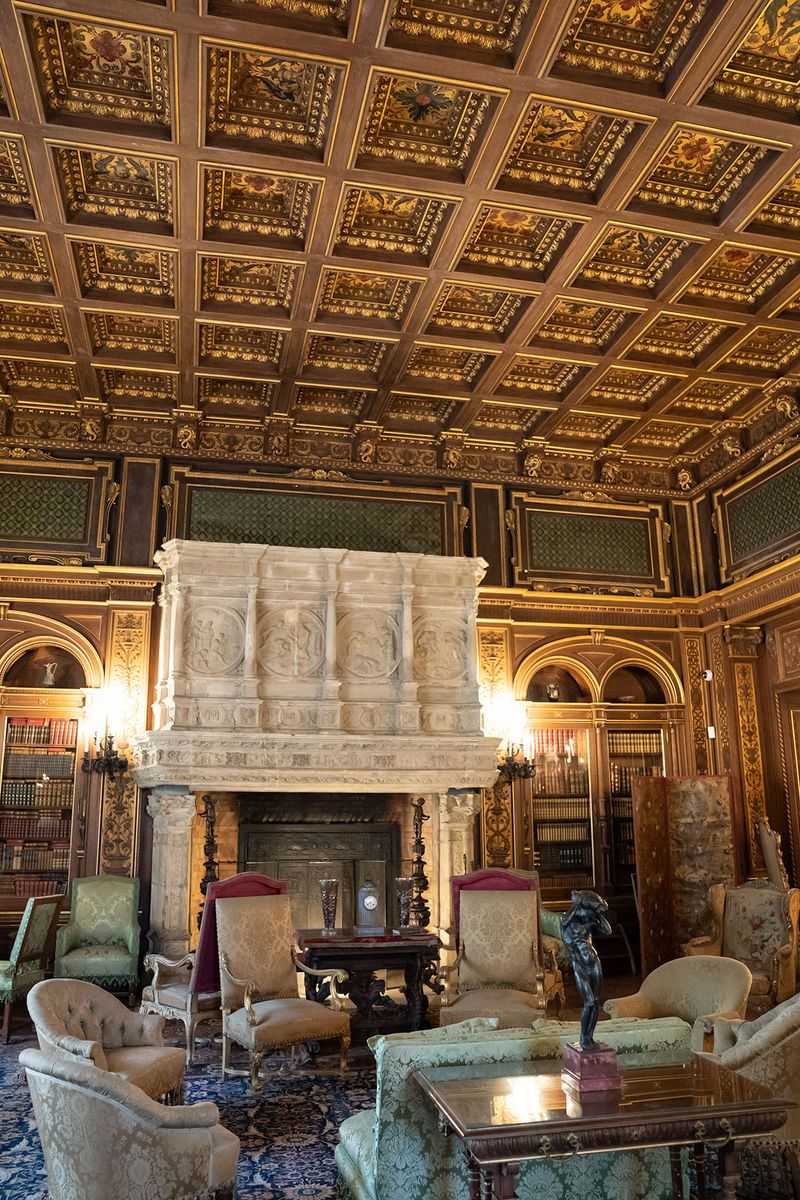
Dark oak paneling rises from floor to ceiling, creating a gentleman’s sanctuary where business deals were sealed between shots. Red Moroccan leather chairs huddle around a tournament-sized billiard table, its green baize still pristine after more than a century.
Heavy carved mantels frame a fireplace large enough to roast a small mammal. Stained glass windows filter sunlight through amber and ruby panes, casting the room in perpetual sunset. Cornelius Vanderbilt’s monogram appears throughout—subtle reminders of who owned the cue stick and everything else.
4. Music Room’s Orchestral Opulence
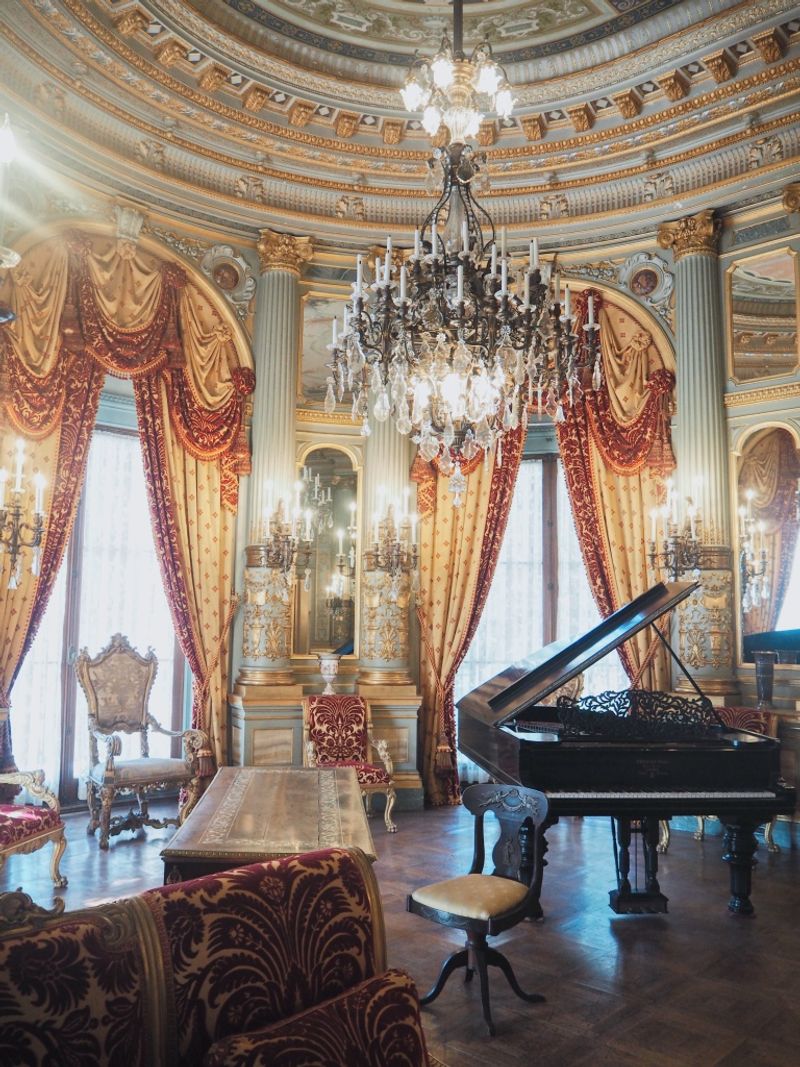
Curved walls wrapped in rose silk create perfect acoustics for chamber music that once floated through this palatial space. A sterling silver baby grand piano—yes, actual silver—anchors the room like a musical throne.
Ceilings painted by French artists depict cherubs and muses floating through cloudy heavens. Gilt chairs upholstered in damask silk stand ready for listeners, though no Vanderbilt ever sat in anything less comfortable than necessary. *When your piano matches your silverware, you’ve officially won the Gilded Age.*
5. Dining Room Fit For Renaissance Royalty
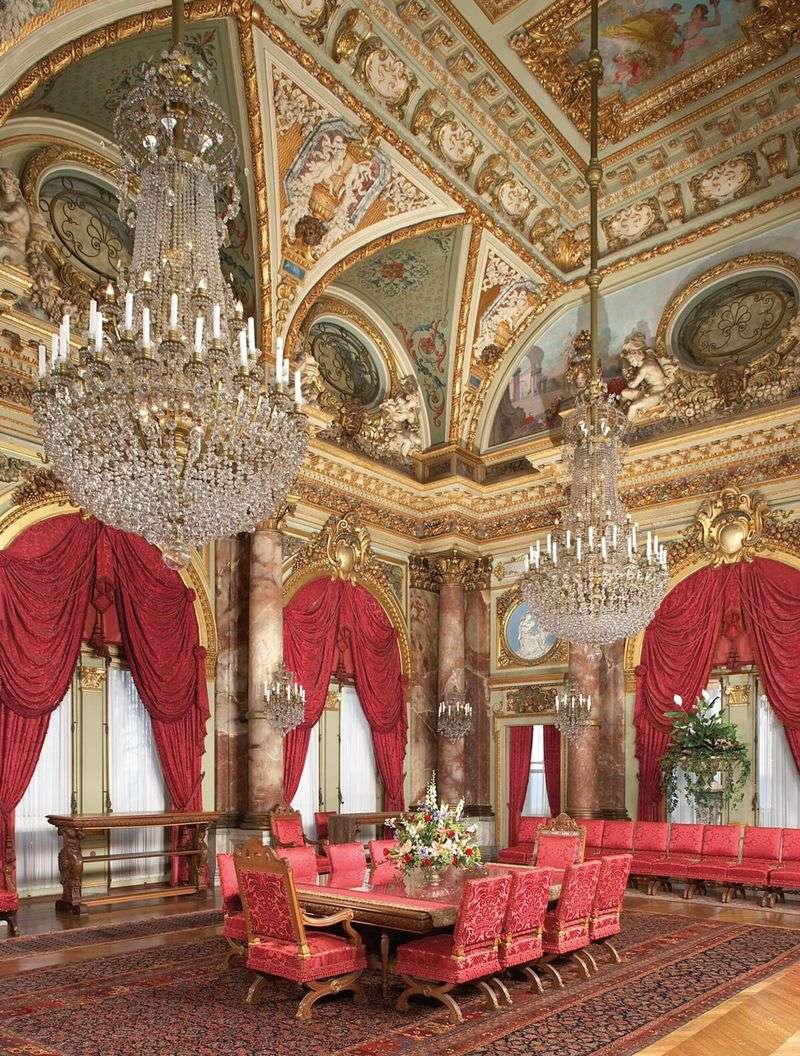
Seventy-foot ceilings soar above a table that could seat 34 guests without anyone bumping elbows. Corinthian columns of rare African marble support an architectural fantasy where Renaissance revival meets American money.
Artisans created a room that feels like dining inside a jewelry box. Gold leaf cascades from ceiling to wall, while Baccarat crystal chandeliers refract light across sterling silver place settings that required their own staff to maintain. The Vanderbilts didn’t just serve dinner—they staged it within a theatrical set designed to awe European nobility.
6. Library’s Leather-Bound Legacy
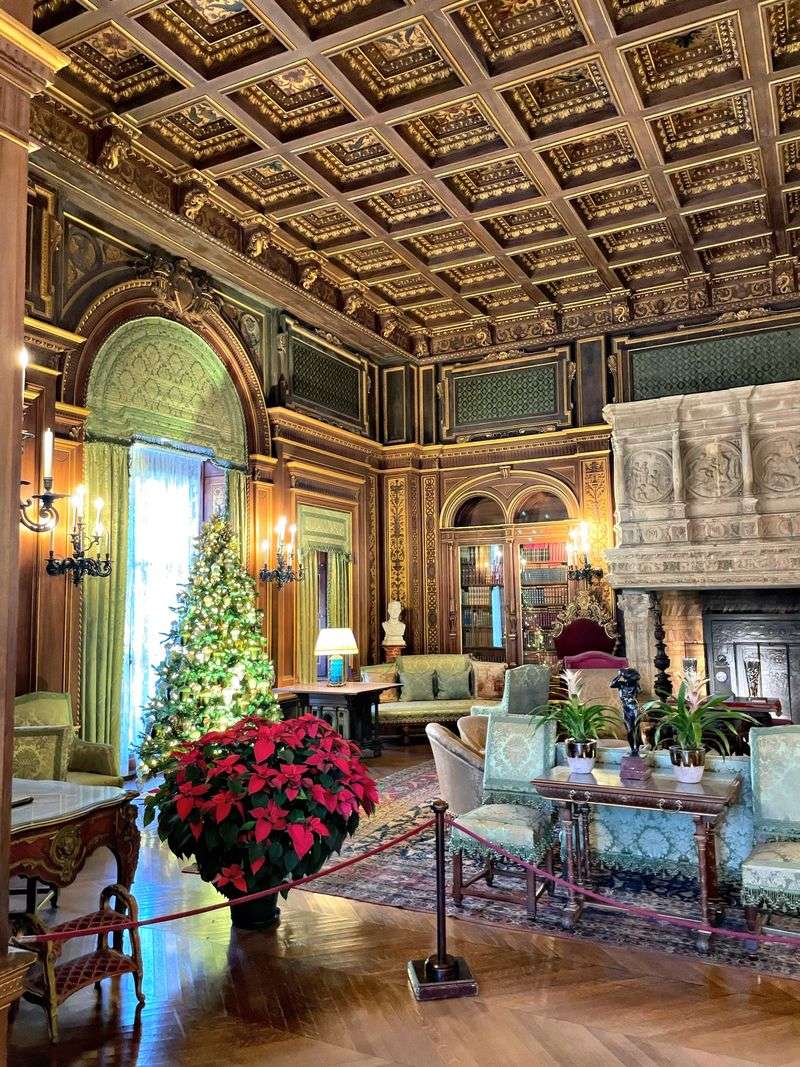
Mahogany bookshelves climb toward coffered ceilings, housing leather-bound volumes that were more status symbol than bedtime reading. Cornelius Vanderbilt’s desk—larger than some Manhattan apartments—dominates the center like a captain’s bridge.
Venetian craftsmen created the room’s intricate coffered ceiling, shipping it across the Atlantic in sections. Green marble fireplace surrounds frame hearths that rarely needed lighting—the home’s innovative central heating system kept books and billionaires perfectly comfortable. *Nothing says ‘well-read’ like 10,000 books you never opened.*
7. Grand Staircase Of Social Ascension
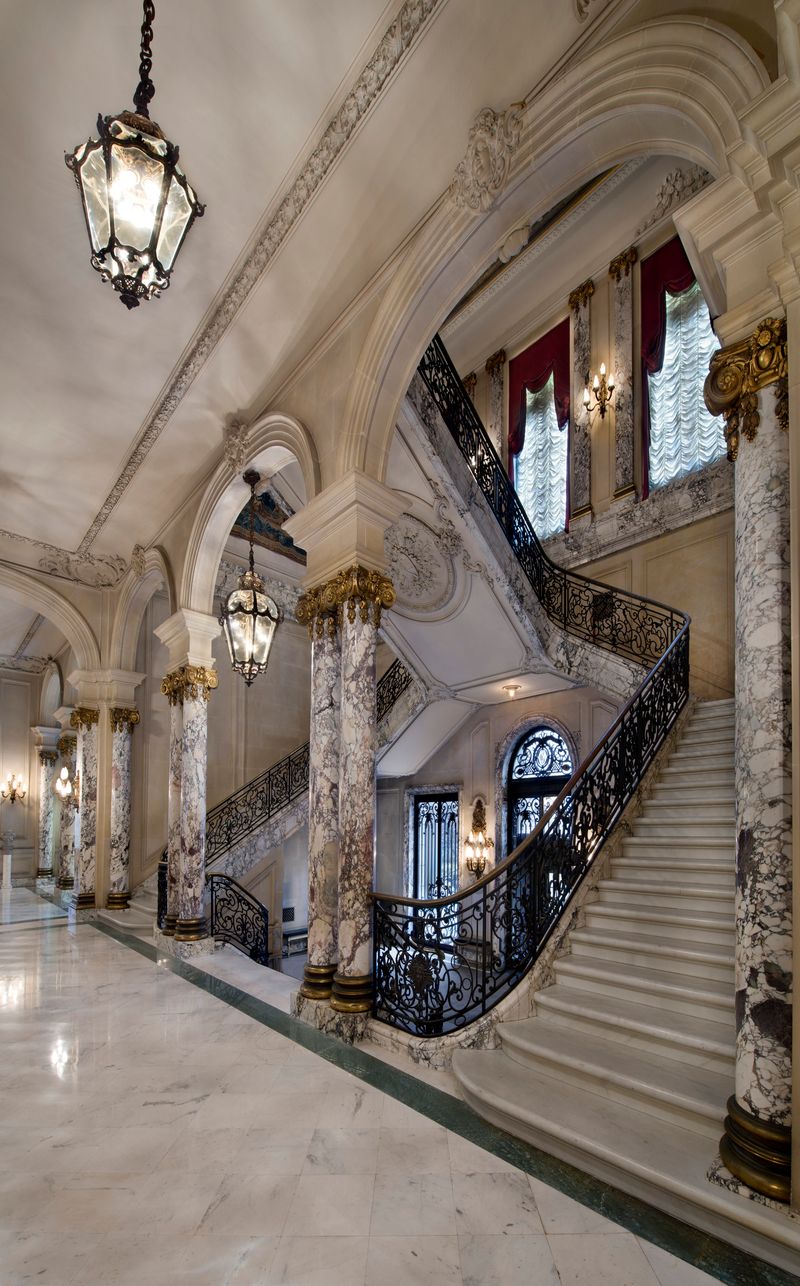
Cascading downward like a limestone waterfall, the Grand Staircase wasn’t just for moving between floors—it was for making entrances. Society debutantes practiced for hours to descend these steps with perfect poise during Vanderbilt balls.
Mosaic tiles create medallions underfoot while a wrought iron and bronze balustrade winds upward with botanical motifs. Overhead, a stained glass skylight bathes climbers in colored light. The architects designed each step’s rise and run for dramatic effect—because when you’re worth $1.5 billion in today’s money, even your stairs make statements.
8. Ballroom’s Gilded Grandeur
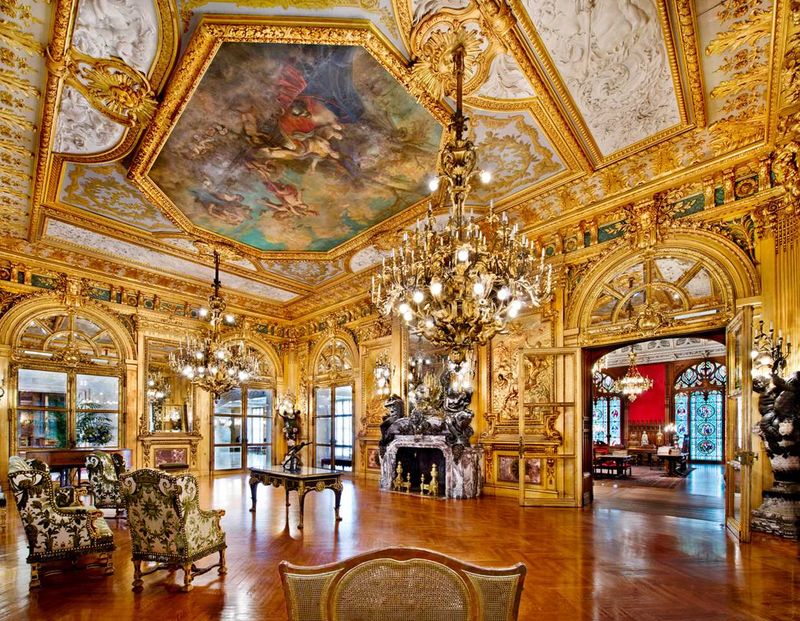
Forty musicians could play from a raised platform while 400 guests waltzed beneath chandeliers dripping with crystal. Twenty-four-karat gold leaf covers every inch of the ceiling—because when you’re a Vanderbilt, even looking up should remind guests of your wealth.
Renaissance-inspired frescoes depict scenes from classical mythology, while mirrors strategically placed between windows create an illusion of endless space. The parquet floor—designed specifically for optimal dancing friction—cost more than an average American would earn in several lifetimes. *The room practically whispers, ‘Your home will never look like this.’*
9. Master Bedroom’s Velvet Dreams

Cornelius and Alice Vanderbilt’s bedroom suite makes modern luxury hotels look like budget accommodations. Walls dressed in hand-embroidered silk panels frame a bed raised on a platform—sleeping at floor level was apparently for commoners.
French cabinetmakers crafted furniture from rare woods, each piece inlaid with mother-of-pearl and bronze. A marble fireplace flaunts carvings so intricate they required magnifying glasses to create. The ceiling features a trompe l’oeil painting of angels watching over the sleeping millionaires. *Even their dreams were probably tax-deductible.*
10. Bathroom Fit For Neptune Himself
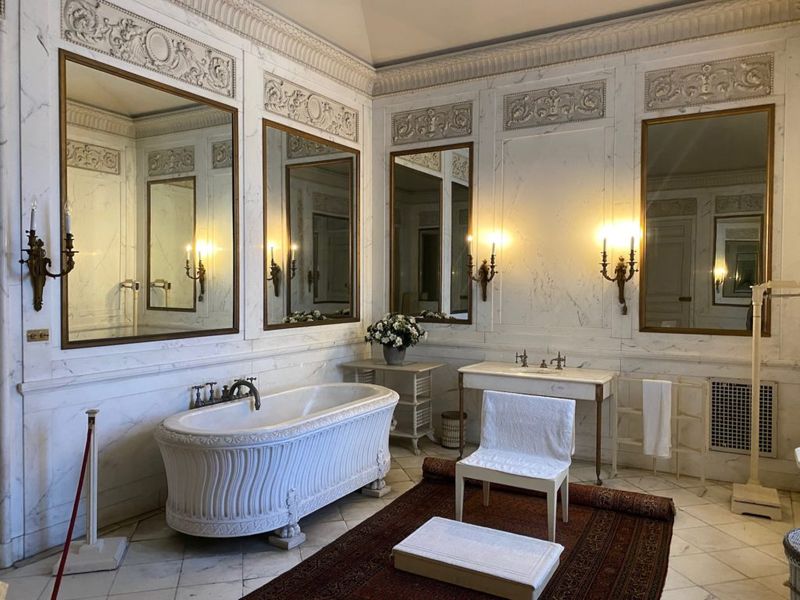
Marble slabs imported from Carrara, Italy line walls that have witnessed more luxury than most five-star spas. Gold-plated fixtures deliver hot and cold running water—revolutionary technology in the 1890s—through pipes hidden behind alabaster panels.
Mosaic floors depict underwater scenes where mermaids and sea creatures frolic beneath one’s feet. A sunken tub carved from a single marble block could accommodate multiple bathers. The Vanderbilts pioneered indoor plumbing not just as necessity but as theater—even their toilet paper probably had a monogram.
11. Lower Loggia’s Mediterranean Escape
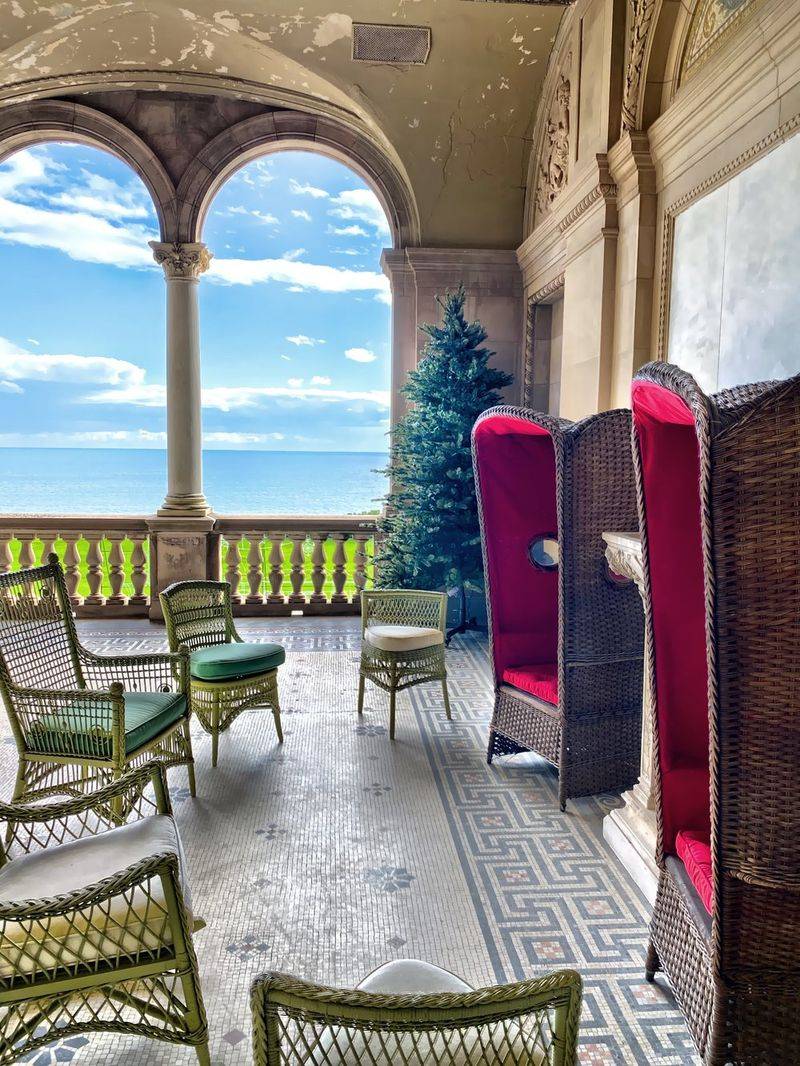
Open archways frame Atlantic Ocean views that cost millions to obtain but are somehow still free to admire. The Vanderbilts created their own Italian coastal villa experience without bothering to visit Italy, importing Mediterranean aesthetics to New England’s rocky shore.
Terracotta tiles cool bare feet while marble columns support a ceiling adorned with nautical motifs. Potted palms and citrus trees once created the ambiance of a European retreat. Servants probably spent hours arranging furniture to capture perfect cross-breezes—because comfort was never supposed to look effortful.
12. Kitchen Complex’s Hidden Industry
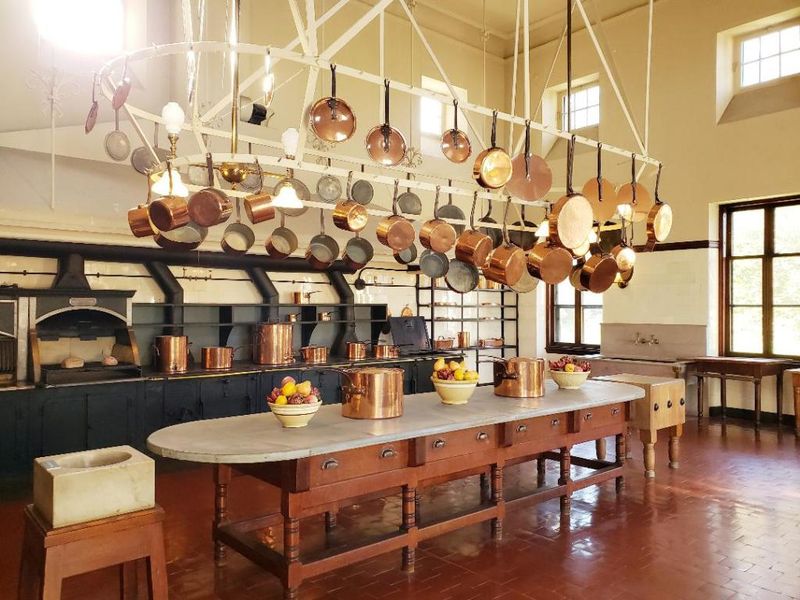
Behind the opulence, a small army prepared feasts in industrial-scale kitchens that operated with military precision. Copper pots hang above cast iron ranges large enough to prepare dinner for fifty without breaking a sweat.
Separate rooms for meat preparation, vegetable cleaning, pastry making, and china storage kept the messy business of feeding the wealthy properly compartmentalized. Bells connected to every room in the mansion summoned servants at all hours. *The staff quarters looked nothing like this—social mobility in the Gilded Age meant climbing stairs, not class ladders.*
13. Children’s Playroom’s Gilded Nursery
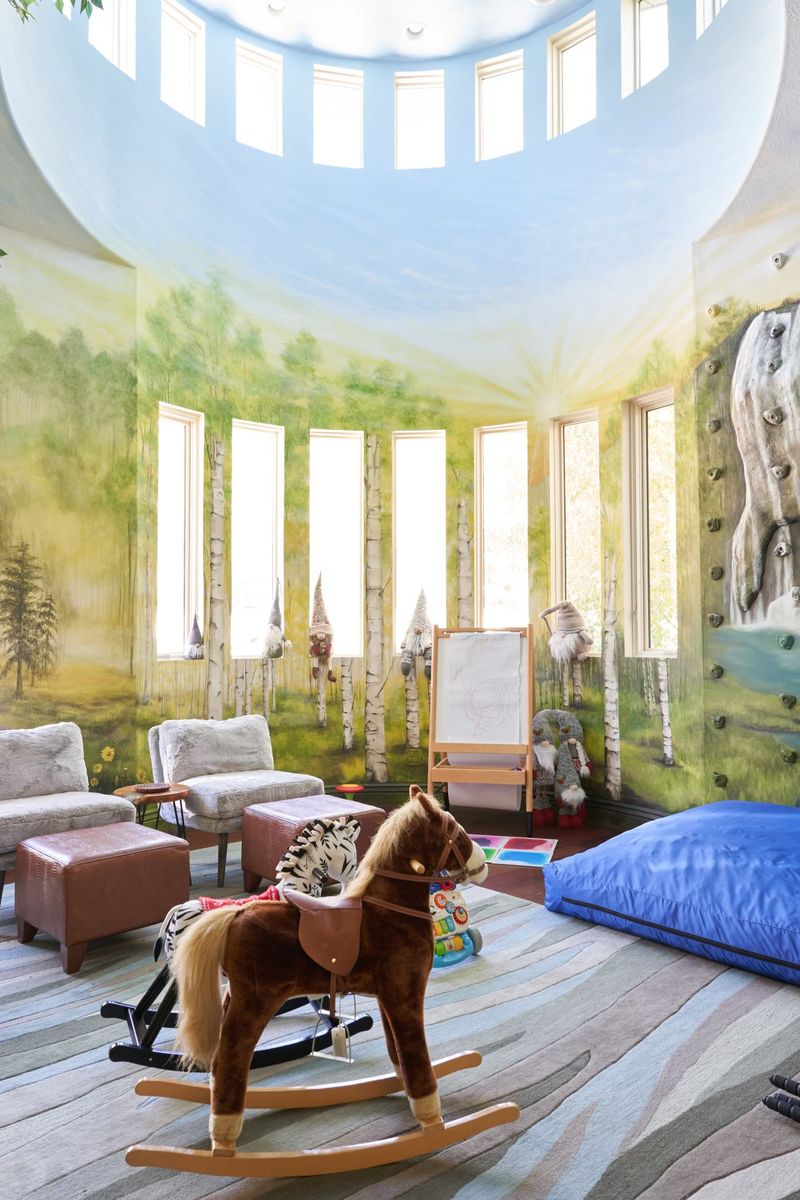
Even the Vanderbilt children’s playroom outshines most modern luxury homes. Hand-painted murals of fairy tales wrap around walls where little heirs played with custom-made toys that cost more than a working family’s annual wage.
A miniature theater built into one wall allowed for puppet shows and child-sized performances. Rocking horses with real horsehair manes and sterling silver stirrups await small riders. The room includes child-scaled furniture that would make today’s design shops weep with envy—because Vanderbilt children learned early that excess was their birthright.
14. Breakfast Room’s Intimate Splendor
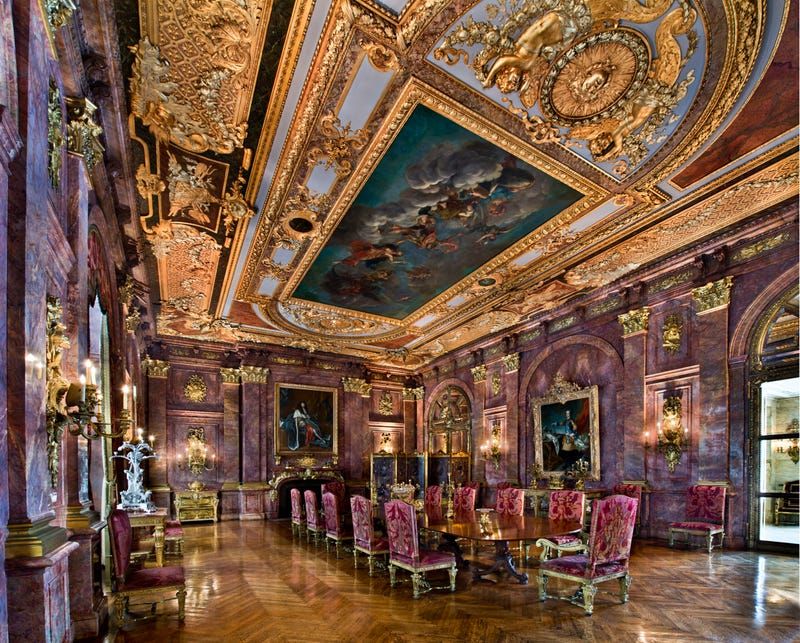
Morning light streams through arched windows, illuminating the only ‘casual’ dining space in the mansion—though casual for a Vanderbilt still meant gilt ceilings and rare marble floors.
Hand-painted Chinese wallpaper depicts exotic birds and flowering branches, creating a garden-like setting for morning meals. The family gathered around a more intimate table (seating merely twelve) beneath a ceiling adorned with cherubs painted by European masters. *Because nothing says ‘pass the toast’ like Renaissance angels watching you eat your eggs.*
15. Back Terrace’s Ocean Symphony
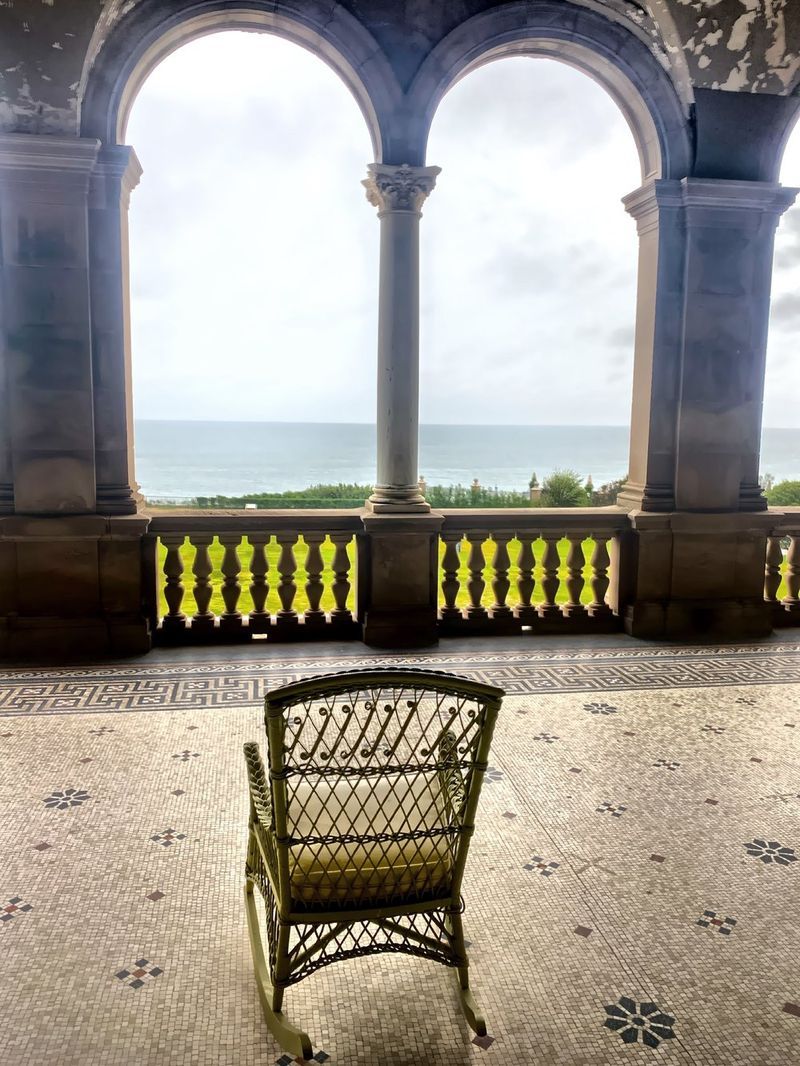
Forty-foot cliffs drop from manicured lawns to crashing Atlantic waves below—a backdrop that makes modern infinity pools look desperately trying. The Vanderbilts positioned their mansion to capture this view, nature’s grandeur becoming merely another asset in their portfolio.
Limestone balusters frame terraces where America’s elite once sipped champagne while discussing railroad stocks and marriage prospects. Italian craftsmen carved stone urns larger than some New York apartments. The landscape design creates an optical illusion where lawn seems to merge with ocean—wealth and nature becoming indistinguishable.
16. The Secret Underground Tunnel
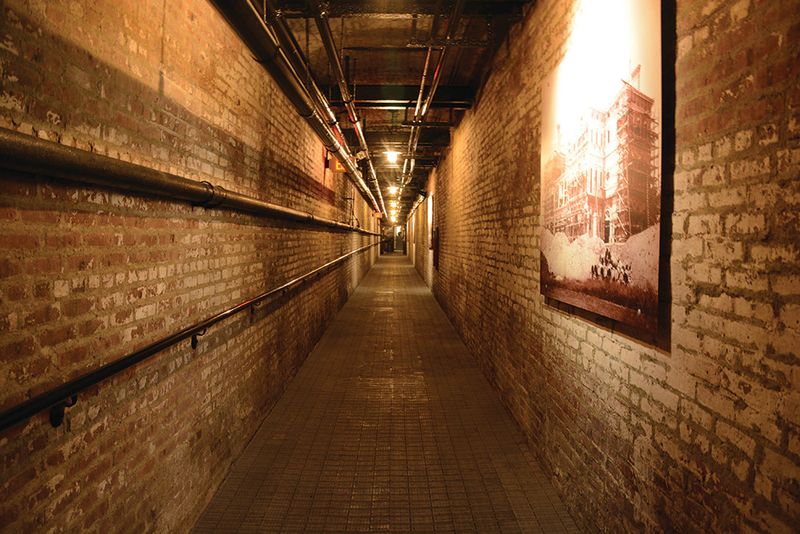
Beneath the glamorous marble floors and gold-leaf ceilings lurks a hidden industrial underworld! The Breakers features a massive coal delivery tunnel where boats could actually dock directly against the mansion’s seawall during high tide.
Though most visitors never see this utilitarian space, it represents the invisible infrastructure that powered the Vanderbilts’ lavish lifestyle.
Workers toiled in these sooty passageways while the family entertained in sunlit splendor above. This engineering marvel reminds us that even extreme luxury required practical solutions!
17. The Vintage Wine Cellar

The rustic stone archway welcomes you into a world where time is measured in vintages and every bottle holds a story. Dim lighting casts a mysterious glow, creating an atmosphere ripe for exploration.
Wooden racks line the walls, each bottle carefully placed as if composing a symphony of flavors and aromas. The air carries the earthy scent of aged oak, and the cool temperature ensures the wines remain in perfect condition, waiting for a special occasion.
Here, connoisseurs find joy, and every visit becomes a journey through the rich tapestry of viniculture.

